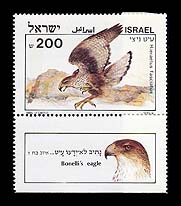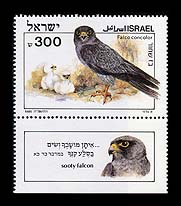|
Anyone who has watched an eagle proudly soaring the length of a desert ravine to swoop down with amazing speed on its prey, or the broad-winged vulture gently feeding its young in the nest, becomes aware of their function in life.
As long ago as 3000 BCE, our forefathers marvelled at the strength of the birds of prey - their hooked beaks, their large wing span, their long sharp talons. The falcon and the eagle were holy symbols to the Egyptians, Assyrians, Greeks and others and are mentioned frequently in the Bible.
Israel's position at the junction of three continents enables its inhabitants to see 45 different species of birds of prey - some of them are permanent resident features of the countryside; others spend the summer or winter months here while many others merely fly over in the course of their winter and spring migration, As a result of the rapid development of the country that has
taken place since the establishment of the State of Israel and the extensive use of pesticides, much damage has been inflicted on Israel's birds of prey and many of them have been completely eliminated or drastically reduced in numbers. Man's disturbance of the balance of nature has affected the role played by the birds of prey in eating various creatures harmful to agriculture, such as rodents, partridges and hares. Today, all Israel's birds of prey are protected by law and it is forbidden to harm them in any way.
It should be noted that in this respect, Israel is unique among all the surrounding countries of the middle east so that it is doubly important for us to continue to protect the rare species of birds still to be found in the country. As a result of surveys undertaken by the Society for the Protection of Nature in Israel, it has been found that hundreds of thousands of birds of prey fly over Israel in the autumn and spring and, in recent years, there has been a growing interest in watching their migration, not only among the local population, but on the part of birdwatchers who come from all over the world to view this wonderful spectacle.
In the past, the Negev and the Judean Desert served as a place of refuge for Jewish zealots, monks and others who wished to live in isolation. Today, it serves as a safe home for many birds of prey who build their nests there in peace and quiet. This set of four stamps illustrates four of these birds.
The lappet-faced vulture (Torgos tracheliotus negevensis) is the largest bird of prey to be found in the country. Its wing span reaches 3 meters and it is distinguished by its broad and long wings and its short tail which barely extends from its body. Its beak is thick and strong and can easily pierce the skin of the carcasses on which it feeds.
The birds that make their nests in Israel are a sub-species, differing in appearance from those that are found in Africa, and have been named "negevensis" after their nesting places in the Negev and Arava, The species is on the verge of extinction, with only two pairs known to be nesting in the south of the Arava.
The University of Tel Aviv has constructed an aviary which holds eight of these vultures and is attempting to breed them in captivity and then let them free in their natural habitat of the Negev and Arava.
These birds nest in the acacia tree and construct nests of as much as 3 meters in diameter.
Bonelli's eagle (Hieraetus fasciatus) was, in the past, the most common eagle to be found in Israel and pairs of them could be found in every rocky wadi in the Carmel, the Galilee and the Judean Hills. However, with the increasing use of pesticides, most of them have been eliminated and, today, there remain very few nesting pairs. They are able to fly at very high speeds, reaching as much as 125 m.p.h., as they wheel and dive after their prey. They feed mainly on partridges, rock doves and hares. The female lays two eggs on which she sits for 42 days. During recent years there has been a slow improvement in the situation of both the Bonelli's Eagle and the Golden Eagle and, after an absence of some 25 years, 2 pairs have returned to make their nests in the Judean Hills and in the Galilee.
The sooty falcon (Falco concolor) is the only bird of prey which is nesting in Israel in the autumn (August -October). The reason for this is to be found in its diet which is based on those migratory birds passing over Israel at this time of the year on their way south. Its long, slender wings enable it to dive at speed on its prey and catch its quota of swifts, swallows, bee-eaters and others. Israel is the furthest point north that it is found. It is a typical desert bird and is found in the mountains of Elat and Sinai, in the Negev and in the Judean Desert. Like all other falcons, the sooty falcon does not build a nest but deposits its eggs in the niches of prominent rocks. It is the female that sits on the eggs and feeds the young, while it is the task of the male to search for food.
Griffon vulture (Gyps fulvus). The vulture is regarded as the king of the birds. Its wing span reaches some 2.4 meters and enables it to soar for hours over long distances without having to flap its wings. It nests in colonies which might contain dozens of vultures. Each morning, as the air warms up, the vultures fly high into the sky, scanning the ground below looking for carcasses. They are endowed with very keen vision, far superior to that of man, The vultures have a very important role to play in clearing the area of natural debris and have been christened "nature's scavengers". After they have gorged themselves on a carcass they are able to go for days without food. Vultures are known to be a long-lived species and can live to over 50.




